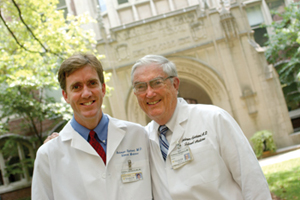
Anderson Spickard III, M.D., left, has led a professional life almost identical to that of his father, Anderson “Andy” Spickard Jr., M.D. Both work at Vanderbilt University Medical Center as general internal medicine physicians. Photo by Dana Johnson
Grant will fund construction of Children's Hospital helipad
When it comes to treating critically ill children and infants, minutes can mean the difference between life and death.
A $1.1 million grant has been given by Rutherford County’s Christy-Houston Foundation to fund the construction of a helipad atop the Monroe Carell Jr. Children’s Hospital at Vanderbilt.
The new helipad will help shave off crucial minutes when transporting Children’s Hospital patients via helicopter. Currently, LifeFlight and other helicopters transporting children must land atop Vanderbilt University Medical Center.
Representatives of the Christy-Houston Foundation presented a check today to Vice Chancellor of Health Affairs Harry R. Jacobson, M.D., while members of Vanderbilt LifeFlight watched and praised the foundation for the gift.
“The number one, two, three and four reasons for this helipad is it will save lives,” said Ian Burr, M.D., associate vice chancellor for Children’s Health Services, and the Vanderbilt leader of the negotiations with the Christy-Houston Foundation. “The Foundation knows that children who are transported from Rutherford County can make it to the helipad atop Vanderbilt Hospital within about 11 minutes, but from that helipad, down to the fourth floor and across the connector to the Children’s Hospital can take longer. We need to eliminate that extra time for children and babies who are critically ill or injured.”
The Christy-Houston Foundation serves the interests of the citizens of Rutherford County. When asked about the donation, Larry Haynes, president and chairman of the board of the foundation said he would prefer credit go to Burr.
“It’s because of his education that we know the Children’s Hospital is truly the hospital of the most seriously ill children in our community,” Haynes said. “Five hundred children from Rutherford County are treated as inpatients at the Children’s Hospital every year, and thousands more get outpatient treatment.”
John A. Morris Jr., M.D., professor of Surgery and director of the division of Trauma and Surgical Critical Care, said the gift helped complete a comprehensive and sophisticated transportation system operated by LifeFlight.
“The lack of a helipad on Children’s Hospital was a key missing piece in our ability to deliver exceptional clinical care to the children in this region,” Morris said. “Now we’re able to complete that system, which allows for Vanderbilt to a deliver comprehensive transportation system to children throughout the region.”
Morris serves as medical director for LifeFlight.
Out of the 2,500 flights made each year by Vanderbilt LifeFlight, 30 percent of those are children who will directly benefit from the helipad, explained Jeanne Yeatman, R.N., program director of LifeFlight.
“The LifeFlight team is very excited,” Yeatman said. “This directly impacts patient care, and has a great impact on our program and how we deliver care to the children in the region.”
When the Children’s Hospital was under construction, designers planned for a future helipad, ensuring a quick and efficient path to get patients from the helicopters to the patient transport elevators.
The helipad will be located on the roof above the middle tower of patient rooms at the Children’s Hospital. An access door will be put into a wall on the 9th floor which currently holds air conditioning and other systems.
John Sparks, an architect in Space and Facilities Planning, is taking the lead to manage the project.
“As part of the Children’s Hospital’s original design, we had preliminary contact with Federal Aviation Administration (FAA) and fire marshal,” said Sparks. “We extended the columns on the roof and capped them off so that area would be able to support a helipad. Duct work and piping was also raised above where a door would need to go for crews to access the hospital from the pad.”
An elevator on the ninth floor can be specially controlled to allow the crew to get from the roof down to the surgical floor, the two critical care units and the emergency department.
Now that funding is in place, Sparks says the planning and construction will move along quickly. The new helipad could be ready for use in less than a year.













